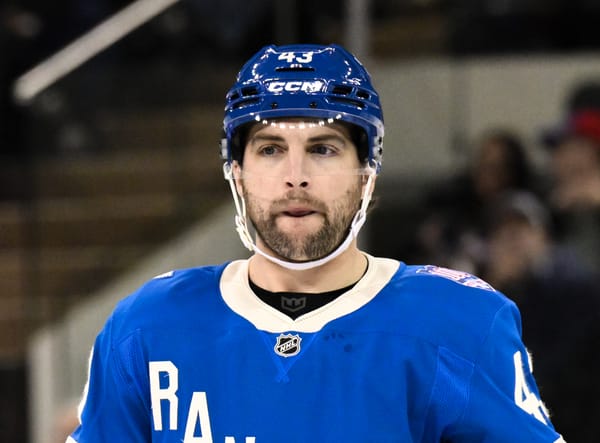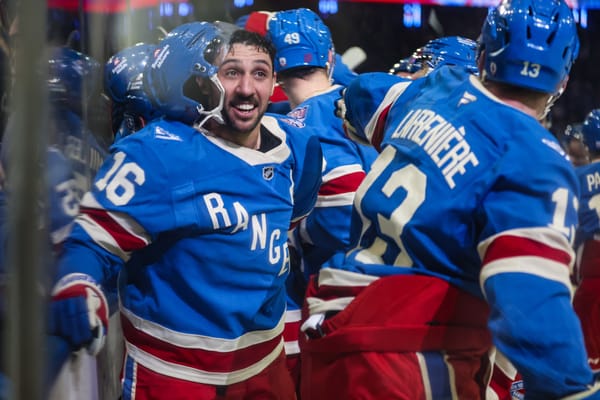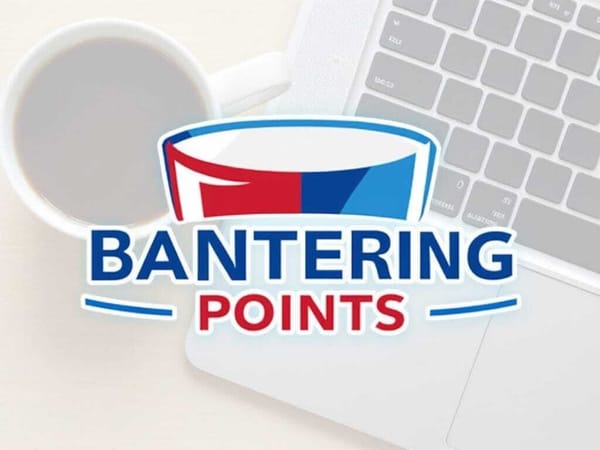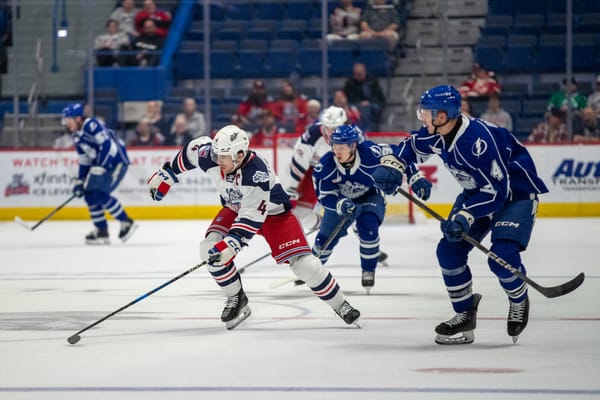Should the Rangers Pursue Ryan O’Reilly?
The veteran center could spearhead the Blueshirts’ new direction
The NHL Entry Draft is encroaching and shaping up to be a transformative couple of days for the rebuilding New York Rangers. In it, the team owns ten selections—including three picks in the opening round—and has been described as being “open for business” regarding its willingness to trade. In the immediate wake of the trade-deadline liquidation, talk of improving the torn down team has been a front-burner issue for general manager Jeff Gorton, who expects to be active in trade talks between now and the first night of the draft.
With a new head coach and his “in your face” philosophy on the way, one name that might prove especially useful as the Blueshirts enter the first full season since their decision to retool is Ryan O’Reilly.
Welcome Back to the Rumor Mill, Ryan
Sitting down with TSN’s Darren Dreger this past May, O’Reilly expressed a desire to remain with the Buffalo Sabres, citing a hope to “create an environment that’s winning.” But a recent update from Dreger suggests a trade out of Buffalo is “more likely now, than not likely”:
Darren Dreger says a Sabres O'Reilly trade is "more likely now, than not likely".
— Jeremy White (@JeremyWGR) June 6, 2018
This will be the first really big move to define Jason Botterill. If he does it, the returns have to be considerable, and some of the impact immediate.
”When I love the game, it’s when I’m competitive. No matter who I’m lining up against, I’m going to outplay that guy. And at times, yeah, I lost that. That’s the reason why I wasn’t my best in doing what I should be for the team. That needs to change, and I plan to change it,” O’Reilly told Dreger in the candid one-on-one interview.
Despite his plans to stay, a trade would serve both parties. For O’Reilly, whose experience with the perennially losing Sabres caused him to lose his “love of the game”, it would offer a fresh start to re-find his passion to play. And for Buffalo, who are stuck among the NHL’s basement dwellers, it would offer additional assets to build upon in complimenting a new nucleus of Jack Eichel, Casey Mittelstadt, and Rasmus Dahlin.
According to Dreger, Sabres’ GM Jason Botterill is hardly expected to sell O’Reilly—who has five years remaining on his contract at an annual average value (AAV) of $7.5 million—for pennies on the dollar. Rather, he’s almost certainly looking for “several pieces” including “a young NHL player or a prospect, a high draft pick, and maybe something else on top of that.”
So, Why the Rangers?
On paper, the idea of the rebuilding Rangers, of all teams, dealing away assets to acquire a 27-year-old seems peculiar. Those assets—draft picks and young prospects —are the highest form of currency for a team looking to chart a new course to contention. But in reality, it makes plenty of sense for them to entertain the idea, as O’Reilly is a special player who might just be worth the reported asking price that Botterill is seeking.
Justifying the cost for a player of O’Reilly’s caliber is as simple as understanding the success he’s found in spite of playing for a collection of lottery teams. Not to mention the regretable 2015 Tim Horton’s incident for which he was charged with, though eventually acquitted of, impaired driving. While it’s fair to criticize him for his behavior, it’s important to make note of his willingness to own, and learn from it. His personal success, especially in both season’s since he was initially charged, speaks volumes about his character and resolve – both of which could help in leading the Rangers’ new direction.
The Ontario native is renowned for his work ethic and relentlessness on the ice. And despite toiling for years on poorly constructed Colorado Avalanche and Sabres teams, he’s proven to be a highly-productive player.
Over the last five seasons with the Avalanche and Sabres, he’s thrice eclipsed the 60-point mark and has boasted rising, elite faceoff numbers while performing admirably across shot attempts margins, especially relative to his teammates. While an aggregate Corsi for percentage (CF%) of 49.0 and a 3.0 relative CF% over that span don’t scream possession monster, they do speak volumes about his dependability in the face of disaster. To be able to score as he does and flirt with positive possession metrics is a feat in and of itself given the state of some of the rosters he’s played on.
That combination of hustle and scoring is precisely what should endear him to the Rangers, who, under new head coach David Quinn, are vowing to play a more aggressive brand of hockey. That brand is one O’Reilly would not only meet the criteria for but could potentially quarterback, doubling as a team leader.
Though he went unmentioned by name when I spoke to Quinn’s new direction back on June 1, O’Reilly hits every mark regarding the Rangers’ desire to improve team toughness. His history as a vocal leader in the dressing room would only add to his value, especially for a team as self-critical of their own leadership group as the Rangers have been since their season ended.
“We need strong leadership in the locker room. I don’t think we had great leadership last year,” Garden executive James Dolan said reflecting on the lost season back in April.
OK, But At What Cost?
While the Rangers aren’t exactly hurting for center depth, things could change following the draft where, as mentioned earlier, they expect to be extremely active. Restricted free agents (RFA), Vladislav Namestnikov and Ryan Spooner—both acquired at the deadline and arbitration-eligible—could be trade fodder. There’s also fellow arbitration-eligible RFA Kevin Hayes to consider the future of, and though they finished the year with the big club, it would be unwise for the Blueshirts to ink permanent roster spots for teenagers Filip Chytil and Lias Andersson just yet.
Zibanejad and ROR as your 1-2 down the middle next season with Lias and Filip on the way sounds prettayyyy prettay good. https://t.co/rYe6EJNu8U
— Tweet Stemkowski (@lackinggrit) June 6, 2018
Hayes, in fact, could be the type of linchpin component required for swinging a deal of this magnitude. Only one year younger than O’Reilly, he’s shown glimpses of solid offensive production as a shutdown center last season and in more sheltered minutes in years past.
Moreover, while Hayes, too, stands to sign a long-term extension this summer, the Sabres might welcome his contract over O’Reilly’s based on structure alone. The latter is due a $7.5 million signing bonus this July 1st and is due an additional $20 million in signing bonuses over the final four years of his deal.
On top of being a productive center, ROR is about to enter Year 3 of his frontloaded 7-year deal. Acquiring team would be getting 87 cents on the actual- salary-to-cap-hit dollar. Even cheaper if BUF trades him after mid-July and eats his $7.5m signing bonus.
— HockeyStatMiner (@HockeyStatMiner) June 6, 2018
As a hypothetical, would an offer of Hayes, the 26th overall (from Boston), and defensive prospect Sean Day be enough for Botterill to part with his star pivot? Day—a smooth-skating puck-moving defender—closed out his final OHL season in high-scoring fashion with 47 points in 50 regular games split between the Windsor Spitfires and Kingston Frontenacs. And his game didn’t waver in the playoffs, where he registered an additional 14 points in 16 playoff matches with Kingston through the first three rounds.
If the Rangers could get the Sabres to retain his $1 million base pay for each remaining year on his deal, the narrative that O’Reilly isn’t worth his AAV could easily be dispensed with. Juxtaposed directly with Hayes, who will likely sign for north of $5.3 million against the cap on a long-term extension this summer, O’Reilly would remain the superior player, but with a more palatable AAV.
While speaking of a desire to improve and actually improving don’t always run in tandem, the Rangers are in a unique position to attempt something of an accelerated pace to their rebuilding plan. Trading for someone of O’Reilly’s pedigree would inarguably fuel that, though the degree of risk the Rangers would accept by doing so is arguable. After all, there’s no precedent that’s been set in recent years among teams who’ve accepted a similar fate in resetting that doing so at an increased pace gets you where you need to be any faster. If anything, those who’ve tried, like Buffalo, failed for it.
Still, it’s no more likely that the Rangers will accept a multi-year bottom out effort, or lack thereof, either. Least of all with Henrik Lundqvist’s visible NHL shelf life to be mindful of.
Regardless, even a resetting team like the Rangers would be markedly improved by the addition of a Quinn prototype like O’Reilly. Rebuilds often put a heavy focus on the most skilled young players, but the conditions those fledglings are groomed in is of equal, if not greater importance. After all, it wouldn’t just be O’Reilly’s addition to a harder-working roster that matters here, but also his impact on future Blueshirts who would benefit from learning under his wing.
All stats via Corsica.hockey unless otherwise noted. Financial information via Cap Friendly unless otherwise noted.





